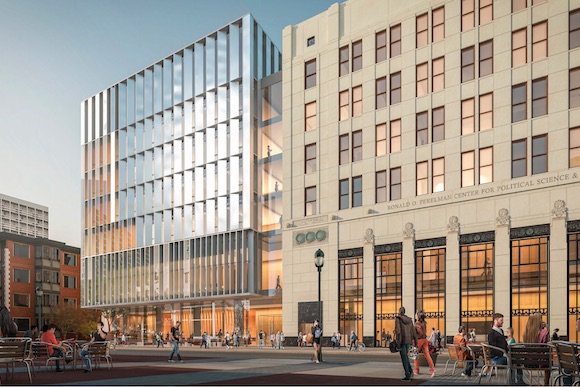University of Pennsylvania architect David Hollenberg says the new Ronald O. Perelman Center for Political Science and Economics, slated to open in 2018 at 36th and Walnut Streets in West Philadelphia, is going to be “a very handsome treatment of a very handsome building.”
Penn just announced its official approval of the new facility’s design after a year of working with Toronto-based architecture firm KPMB. The old nine-story West Philadelphia Title and Trust Company building at 133 S. 36th Street (built in the mid-1920s) will join with a brand-new addition to its north for a space totaling about 100,000 square feet. The new center will house Penn’s Political Science and Economics Departments, as well as six relocated academic and research centers.
“To a lot of folks, this is an important survivor of the West Philly commercial landscape,” says Hollenberg of efforts to retain the original building’s look. “We’re very interested in preserving that remnant.”
But it’s just the exterior of the building that Penn is holding on to.
“Most of the interior is going to be gutted; it’s really about the façade,” explains Hollenberg.
The north-side addition isn’t just a new wing, either. It will be roughly the same size as the existing building, with a main entrance on 36th Street where the new and old structures meet. According to a statement from Penn, “the addition’s exterior palette of silver metal, frosted and clear glass is also designed to complement the historic limestone façade.”
The six-story addition will be “an equal partner to a very distinguished historic building,” Hollenberg predicts. And he says this is typical of the Penn architectural style, which instead of aiming for a single look across campus, strives to respect the unique aspects of existing buildings “that are the best of their time.”
The architect points out that the building is also significant because of major shifts in Penn’s undergraduate population, most of which has been concentrated south of Walnut Street until now.
“This is the first building that will take a significant undergraduate academic function across Walnut Street,” he says, noting that political science and economics are two of Penn’s most popular undergraduate majors. The daily traffic from those students will
“have a significant impact on that northern side of the campus.”
The $77.6 million project is scheduled to break ground this December and be completed by spring of 2018. Hollenberg says the new facilities will be ready to welcome students and faculty for the fall semester of 2018.


